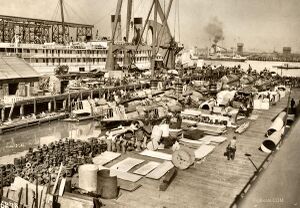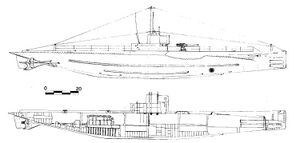R-class: Difference between revisions
Pbcjohnston (talk | contribs) trying justification |
Pbcjohnston (talk | contribs) mNo edit summary |
||
| Line 20: | Line 20: | ||
[[File:Red bar sub.jpg]] | [[File:Red bar sub.jpg]] | ||
[[File:Lake R-class drawing.jpg|left|thumb|Drawing by Jim Christley courtesy of Navsource.org]] | [[File:Lake R-class drawing.jpg|left|thumb|Drawing by Jim Christley courtesy of Navsource.org]] | ||
An excellent line drawing of the Lake design for the R-class. Simon Lake finally abandoned the concept of level keel diving with midships diving planes in this class, at the Navy's insistence. The flat horizontal stern and the ventrally mounted rudder, stern planes, and propeller shafts are quite apparent. <br><br> | An excellent line drawing by artist/historian Jim Christley of the Lake design for the R-class. Simon Lake finally abandoned the concept of level keel diving with midships diving planes in this class, at the Navy's insistence. The flat horizontal stern and the ventrally mounted rudder, stern planes, and propeller shafts are quite apparent. <br><br> | ||
[[R-21 through R-27|See more of this group]] | [[R-21 through R-27|See more of this group]] | ||
Revision as of 14:34, 2 May 2023
Design and Construction Notes
![]()
The 27 R-class submarines were built to two distinctly different designs at three shipyards. Both designs had similar operational and military characteristics, but had vastly different internal arrangements, equipment installations, and external appearances. The two designs were developed by the Electric Boat Company (EB) of New York City (later Groton, CT.) and the Lake Torpedo Boat Company of Bridgeport, CT. R-1 through R-14 were of the EB design and were built at Bethlehem Quincy near Boston (formerly Fore River Shipbuilding Company). R-15 through R-20 were of the EB design and built at Bethlehem San Francisco (formerly Union Iron Works). R-21 through R-27 were built by Lake at his Bridgeport yard.
The class is broken down by groups below.
R-1 through R-14 (EB design built at Bethlehem Quincy)
![]()
See more of this group
R-15 through R-20 (EB design built at Bethlehem San Francisco)
![]()

BSF launched their boats with much of the superstructure and the conning tower fairwater yet to be installed, and with a false bow that was later replaced with the permanent one prior to completion. This is in marked contrast to the Bethlehem Quincy (BQ) yard near Boston (previously known as Fore River Shipbuilding) that built their group of R-boats with most of the superstructure complete and the conning tower fairwater in place. The cylindrical ribbed tower in the center of each boat is the pressure proof conning tower itself, used as a periscope station for making submerged attacks. Later in the construction phase a sheet steel fairwater would be built around the conning tower to provide a smooth flow of water around the tower, to provide a bridge for the Officer of the Deck and lookouts while surfaced, and to provide supports for the periscopes.
The docks on both sides of the submarines are stacked with huge amounts of materials for ship construction. BSF was also building destroyers and civilian merchant ships at this time and much of this material may be for those ships, as some of it is too large for submarines. What looks like huge sheets of cork insulation are stacked near the center of the photograph. This was applied to the interior of the pressure hull to help control the temperature of the interior of the boat. It was also to prevent condensation from dripping all over the crew and equipment causing discomfort and electrical shorts and grounds. There are also piping unions, elbows, and junctions stacked around seemingly by the hundreds.
See more of this group
R-21 through R-27 (Lake design built at Lake Torpedo Boat Company)
![]()

An excellent line drawing by artist/historian Jim Christley of the Lake design for the R-class. Simon Lake finally abandoned the concept of level keel diving with midships diving planes in this class, at the Navy's insistence. The flat horizontal stern and the ventrally mounted rudder, stern planes, and propeller shafts are quite apparent.
See more of this group